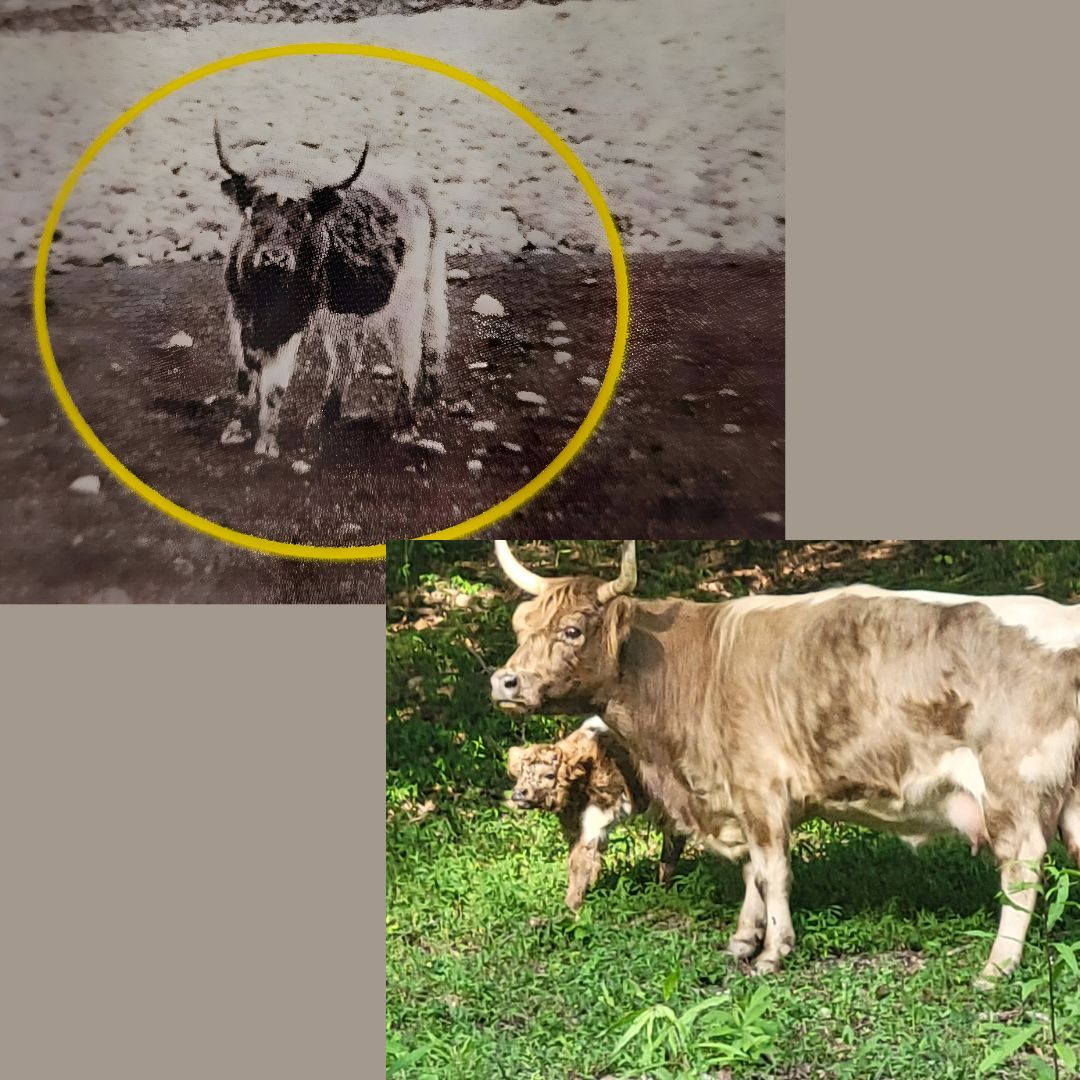
𝐓𝐡𝐞 𝐅𝐚𝐬𝐜𝐢𝐧𝐚𝐭𝐢𝐧𝐠 𝐖𝐨𝐫𝐥𝐝 𝐨𝐟 𝐏𝐚𝐫𝐭𝐢-𝐂𝐨𝐥𝐨𝐫𝐞𝐝 𝐇𝐢𝐠𝐡𝐥𝐚𝐧𝐝𝐬 𝐚𝐧𝐝 𝐇𝐢𝐠𝐡𝐏𝐚𝐫𝐤𝐬: 𝐆𝐞𝐧𝐞𝐭𝐢𝐜𝐬, 𝐇𝐢𝐬𝐭𝐨𝐫𝐲, 𝐚𝐧𝐝 𝐌𝐨𝐝𝐞𝐫𝐧 𝐏𝐞𝐫𝐬𝐩𝐞𝐜𝐭𝐢𝐯𝐞𝐬
Share
In the world of Highland cattle, few traits captivate breeders and enthusiasts quite like the striking patterns of Parti-colored Highlands and HighParks. With their unique genetic makeup, deep historical roots, and modern significance, these cattle stand as a testament to both tradition and innovation in livestock breeding. This blog explores the genetics, history, and evolving acceptance of these remarkable animals, offering a comprehensive view of their journey.
The Science Behind Parti-Coloring: The KIT Gene
At the core of the distinctive coloring found in Parti-colored Highlands and HighParks lies the KIT gene. This gene plays a pivotal role in controlling pigmentation by regulating the migration and development of pigment cells (melanocytes) during embryonic development. Variations in the KIT gene disrupt this process, resulting in areas without pigment and creating bold white patches or distinctive tipped features.
-
Parti Highlands: Characterized by bold, irregular patches of white contrasting with traditional Highland colors like red, black, dun, or yellow. Each pattern is entirely unique, adding to their allure.
-
HighParks: Often showcase a white coat with dark-tipped ears, noses, and eyes, complemented by symmetrical spots. This refined look stems from the same genetic foundation but expresses differently.
These variations rely on recessive genetic traits, requiring careful and deliberate breeding to produce the desired patterns. The KIT gene is a testament to the artistry and science involved in livestock genetics, offering breeders tools to diversify and enhance their herds.
Historical Perspectives: From Rejection to Celebration
Scotland: The Birthplace of the Highland
The Highland Cattle Society, established in 1884, originally excluded Parti-colored animals from its registry, favoring uniform solid colors, predominantly black. This preference reflected a desire for consistency and alignment with traditional perceptions of the breed. However, by 1990, the Society officially began allowing Parti-colored Highlands into the herd book, recognizing their genetic and cultural significance. This change marked a pivotal moment in acknowledging the broader heritage of the breed.
Australia: Strict Standards
The Australian Highland Cattle Society recognizes multiple coat colors, including black, brindle, dun, silver dun, red, yellow, and white. However, Parti-colored animals remain ineligible for registration. This exclusion underscores Australia’s focus on maintaining specific breed standards, prioritizing uniformity over variation.
United States: A Middle Ground
The American Highland Cattle Association (AHCA) offers a more nuanced approach:
-
Registration: Parti-colored females are eligible for registration if DNA parentage verification is completed, while males are excluded.
-
Exhibition: Parti-colored animals are prohibited from AHCA-sanctioned shows, ensuring traditional solid-colored cattle dominate the competition stage.
This approach reflects a blend of preserving breed standards while recognizing the genetic diversity that Parti-colored cattle bring.
The Role of Advancing Genetic Knowledge
Modern advancements in genetic testing and DNA analysis have significantly influenced the perception and inclusion of Parti-colored Highlands. Growing genome mapping has enabled breeders to analyze specific genetic traits, providing insights into parentage, coat color, and overall herd quality. These developments have allowed associations and breeders to make more informed decisions, balancing tradition with innovation.
-
Parentage Verification: Ensures herd book integrity and supports the inclusion of genetically verified Parti-colored cattle.
-
Trait Selection: Advances in genetic analysis help breeders optimize their herds for temperament, coat quality, and other desirable traits while responsibly managing recessive genes.
These tools have contributed to a growing appreciation for the genetic complexity and diversity represented by Parti-colored Highlands.
Parti Highlands vs. HighParks: A Comparative View
While Parti Highlands and HighParks share the KIT gene as a foundation for their coloring, they differ in key ways:
|
Feature |
Parti Highlands |
HighParks |
|
Color Patterns |
Irregular bold white patches with solid colors |
White coats with dark-tipped features and spots |
|
Horns |
Always horned |
Can be horned or polled |
|
Coat Style |
Traditional shaggy, double-layered coat |
Variable coat length, maybe sleeker and shorter |
|
Heritage |
Rooted in the historical Highland breed |
A more modern development blending multiple genetics |
Polarizing Perspectives
Parti-colored Highlands and HighParks occupy a unique and sometimes controversial space in the cattle world.
-
Advocates celebrate their rarity, beauty, and the genetic diversity they bring to herds. Parti coloring, once excluded from registries, is now seen as a historical legacy and a marker of the breed’s versatility.
-
Critics argue that these patterns deviate from traditional breed standards, raising concerns about preserving the iconic image of Highland cattle.
This ongoing dialogue highlights the evolving nature of livestock breeding, where tradition and innovation often intersect.
A Legacy Worth Preserving
Photographs from the 19th century, such as those found in Una Flora Cochrane’s Highland Cattle Galore, depict Parti-colored cattle remarkably similar to today’s examples, underscoring their enduring presence in the breed’s history. While HighParks are a more recent development, they embody the same spirit of innovation and diversity, offering breeders new opportunities to expand their herds.
Whether you’re captivated by the bold patterns of Parti Highlands or the refined elegance of HighParks, these cattle reflect the artistry of genetics and the richness of Highland heritage.
Conclusion: Honoring Tradition and Embracing Diversity
The story of Parti-colored Highlands and HighParks is one of transformation. From being shunned in the past to celebrated today, their journey showcases the power of genetics, the value of diversity, and the importance of open-mindedness in agriculture. By understanding their history and science, we honor their legacy while building a brighter, more inclusive future for Highland cattle.
References
-
Highland Cattle Society. (n.d.). Using genetics. Retrieved from https://www.highlandcattlesociety.com
-
American Highland Cattle Association. (n.d.). Rules and regulations. Retrieved from https://www.highlandcattleusa.org
-
Bairnsley Farm. (n.d.). Coat colour basics in Highlands. Retrieved from https://www.bairnsley.com
-
Cochrane, U. F. (1990). Highland Cattle Galore.
